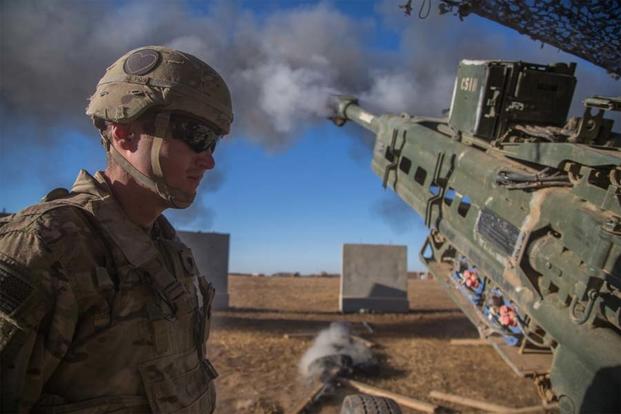U.S. advisers moving with Iraqi forces are now operating on the front lines in the house-to-house fighting against the Islamic State inside Mosul as the number of U.S. and coalition advisers involved in retaking the city has doubled to 450 in recent weeks, a U.S. military spokesman said Wednesday.
"They have been in the city at different times" to advise and assist in what is now a three-pronged offensive focused on the eastern sector of Mosul, said Air Force Col. John Dorrian, a spokesman for Combined Joint Task Force-Operation Inherent Resolve.
To back up the renewed offensive, which began Dec. 29 after a two-week lull, there are now "maybe around 450 advise and assist forces. That is right about double what we have been doing before," Dorrian said in a televideo conference from Baghdad to the Pentagon.
"We have increased the number of advise and assist forces that are there with the ISF command elements to help advise them as they move forward and to synchronize operations," he said.
The advisers operating in and around Mosul are under instructions to remain behind the Forward Line of Troops, or FLOT, Dorrian said, but he also described a constantly shifting line amid "room-to-room" fighting in urban warfare marked by constant attacks from ISIS Vehicle Borne Improvised Explosive Devices, or VBIED car bombs.
"There are more than 200,000 buildings in Mosul. You end up having to clear each one," which means going through "every single room and every single closet," Dorrian said. "It's going to take time. It's going to be very dangerous."
The Iraqi Security Forces are attempting to clear the eastern sector of Mosul in a drive to the Tigris River, which splits the city, Dorrian said. "Once they get to the river, they're going to go into the west side. There will be a very tough fight there as well."
Currently, there are about 5,000 U.S. troops in Iraq, including trainers and other support forces. Dorrian said the 450 advisers in and around Mosul were drawn from forces already in the country. He said not all of the Mosul advisers are American, but include some coalition advisers.
The Mosul offensive began in October amid predictions from Iraqi Prime Minister Haider al-Abadi that the city could fall before the end of the year. He has revised his prediction to say that ousting ISIS from Mosul will take an additional several months.
Dorrian said the new offensive in Mosul is proceeding along three axes by elements of the elite Counter Terror Services units, the Iraqi army and the Iraqi federal police.
The attacks from different directions are "presenting the enemy with more problems than they can solve," Dorrian said. "The axes are beginning to converge as they progress toward the river," and the ISIS fighters "don't have the resources to defend against all three."
In a November briefing, Dorrian suggested that U.S. advisers had been inside Mosul, but his remarks Wednesday were the first to confirm that they are now operating regularly within the city limits.
President Barack Obama has barred U.S. troops from ground combat in Iraq and Syria while authorizing them to serve as trainers and advisers, which has frequently put them in combat situations.
Earlier in 2016, Army Lt. Gen. Sean MacFarland, then commander of CJTF-OIR, was authorized to place U.S. advisers with the Iraqis at the battalion level and that authority remains with his successor, Army Lt. Gen. Stephen Townsend.
-- Richard Sisk can be reached at Richard.Sisk@Military.com.





























